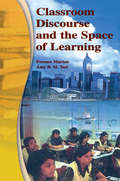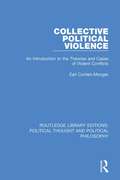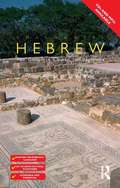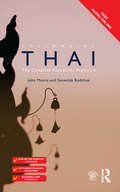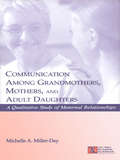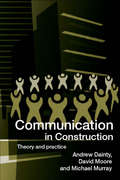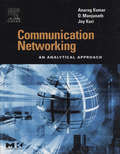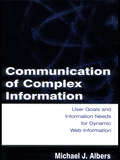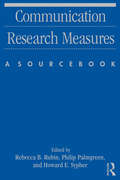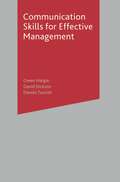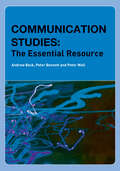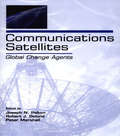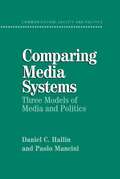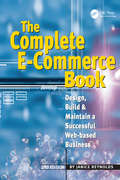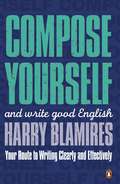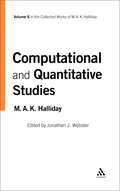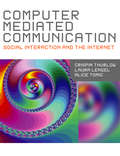- Table View
- List View
Classroom Discourse and the Space of Learning
by Ference Marton Amy B.M. Tsui Pakey P.M. Chik Po Yuk Ko Mun Ling LoClassroom Discourse and the Space of Learning is about learning in schools and the central role of language in learning. The investigations of learning it reports are based on two premises: First, whatever you are trying to learn, there are certain necessary conditions for succeeding--although you cannot be sure that learning will take place when those conditions are met, you can be sure that no learning will occur if they are not. The limits of what is possible to learn is what the authors call "the space of learning." Second, language plays a central role in learning--it does not merely convey meaning, it also creates meaning. The book explicates the necessary conditions for successful learning and employs investigations of classroom discourse data to demonstrate how the space of learning is linguistically constituted in the classroom.Classroom Discourse and the Space of Learning:*makes the case that an understanding of how the space of learning is linguistically constituted in the classroom is best achieved through investigating "classroom discourse" and that finding out what the conditions are for successful learning and bringing them about should be the teacher's primary professional task. Thus, it is fundamentally important for teachers and student teachers to be given opportunities to observe different teachers teaching the same thing, and to analyze and reflect on whether the classroom discourse in which they are engaged maximizes or minimizes the conditions for learning;*is both more culturally situated and more generalizable than many other studies of learning in schools. Each case of classroom teaching clearly demonstrates how the specific language, culture, and pedagogy molds what is happening in the classroom, yet at the same time it is possible to generalize from these culturally specific examples the necessary conditions that must be met for the development of any specific capability regardless of where the learning is taking place and what other conditions might be present; and *encompasses both theory and practice--providing a detailed explication of the theory of learning underlying the analyses of classroom teaching reported, along with close analyses of a number of authentic cases of classroom teaching driven by classroom discourse data which have practical relevance for teachers.Intended for researchers and graduate students in education, teacher educators, and student teachers, Classroom Discourse and the Space of Learning is practice- and content-oriented, theoretical, qualitative, empirical, and focused on language, and links teaching and learning in significant new ways.
Classroom Discourse and the Space of Learning
by Ference Marton Amy B.M. Tsui Pakey P.M. Chik Po Yuk Ko Mun Ling LoClassroom Discourse and the Space of Learning is about learning in schools and the central role of language in learning. The investigations of learning it reports are based on two premises: First, whatever you are trying to learn, there are certain necessary conditions for succeeding--although you cannot be sure that learning will take place when those conditions are met, you can be sure that no learning will occur if they are not. The limits of what is possible to learn is what the authors call "the space of learning." Second, language plays a central role in learning--it does not merely convey meaning, it also creates meaning. The book explicates the necessary conditions for successful learning and employs investigations of classroom discourse data to demonstrate how the space of learning is linguistically constituted in the classroom.Classroom Discourse and the Space of Learning:*makes the case that an understanding of how the space of learning is linguistically constituted in the classroom is best achieved through investigating "classroom discourse" and that finding out what the conditions are for successful learning and bringing them about should be the teacher's primary professional task. Thus, it is fundamentally important for teachers and student teachers to be given opportunities to observe different teachers teaching the same thing, and to analyze and reflect on whether the classroom discourse in which they are engaged maximizes or minimizes the conditions for learning;*is both more culturally situated and more generalizable than many other studies of learning in schools. Each case of classroom teaching clearly demonstrates how the specific language, culture, and pedagogy molds what is happening in the classroom, yet at the same time it is possible to generalize from these culturally specific examples the necessary conditions that must be met for the development of any specific capability regardless of where the learning is taking place and what other conditions might be present; and *encompasses both theory and practice--providing a detailed explication of the theory of learning underlying the analyses of classroom teaching reported, along with close analyses of a number of authentic cases of classroom teaching driven by classroom discourse data which have practical relevance for teachers.Intended for researchers and graduate students in education, teacher educators, and student teachers, Classroom Discourse and the Space of Learning is practice- and content-oriented, theoretical, qualitative, empirical, and focused on language, and links teaching and learning in significant new ways.
Collective Political Violence: An Introduction to the Theories and Cases of Violent Conflicts (Routledge Library Editions: Political Thought and Political Philosophy #16)
by Earl Conteh-MorganFirst published in 2004. Collective Political Violence is a concise, but thorough, interdisciplinary analysis of the many competing concepts, theories, and explanations of political conflict, including revolutions, civil wars, genocide, and terrorism. To further his examination of each type of conflict, Earl Conteh-Morgan presents case studies, from the Rwandan genocide to the civil rights movement in the United States. Along the way, he illuminates new debates concerning terrorism, peacekeeping, and environmental security. Written in a knowledgeable, yet accessible, manner, Collective Political Violence treats the issue of political violence with on impressively wide geographic range, and successfully straddles the ideological divide.
Collective Political Violence: An Introduction to the Theories and Cases of Violent Conflicts (Routledge Library Editions: Political Thought and Political Philosophy #16)
by Earl Conteh-MorganFirst published in 2004. Collective Political Violence is a concise, but thorough, interdisciplinary analysis of the many competing concepts, theories, and explanations of political conflict, including revolutions, civil wars, genocide, and terrorism. To further his examination of each type of conflict, Earl Conteh-Morgan presents case studies, from the Rwandan genocide to the civil rights movement in the United States. Along the way, he illuminates new debates concerning terrorism, peacekeeping, and environmental security. Written in a knowledgeable, yet accessible, manner, Collective Political Violence treats the issue of political violence with on impressively wide geographic range, and successfully straddles the ideological divide.
Colloquial Hebrew
by Zippi Lyttleton Tamar WangColloquial Hebrew provides a step-by-step course in Hebrew as it is written and spoken today. Combining a user-friendly approach with a thorough treatment of the language, it equips learners with the essential skills needed to communicate confidently and effectively in Hebrew in a broad range of situations. No prior knowledge of the language is required. Key features include: • progressive coverage of speaking, listening, reading and writing skills • structured, jargon-free explanations of grammar • an extensive range of focused and stimulating exercises • realistic and entertaining dialogues covering a broad variety of scenarios • useful vocabulary lists throughout the text • additional resources available at the back of the book, including a full answer key, a grammar summary and bilingual glossaries Balanced, comprehensive and rewarding, Colloquial Hebrew will be an indispensable resource both for independent learners and students taking courses in Hebrew. Audio material to accompany the course is available to download freely in MP3 format from www.routledge.com/cw/colloquials. Recorded by native speakers, the audio material features the dialogues and texts from the book and will help develop your listening and pronunciation skills.
Colloquial Thai: The Complete Course For Beginners (Colloquial Ser.)
by John Moore Saowalak RodchueColloquial Thai: The Complete Course for Beginners has been carefully developed by an experienced teacher to provide a step-by-step course to Thai as it is written and spoken today. Combining a clear, practical and accessible style with a methodical and thorough treatment of the language, it equips learners with the essential skills needed to communicate confidently and effectively in Thai in a broad range of situations. No prior knowledge of the language is required. Colloquial Thai is exceptional; each unit presents a wealth of grammatical points that are reinforced with a wide range of exercises for regular practice. A full answer key, a grammar summary, bilingual glossaries and English translations of dialogues can be found at the back as well as useful vocabulary lists throughout. Key features include: A clear, user-friendly format designed to help learners progressively build up their speaking, listening, reading and writing skills Jargon-free, succinct and clearly structured explanations of grammar An extensive range of focused and dynamic supportive exercises Realistic and entertaining dialogues covering a broad variety of narrative situations Helpful cultural points explaining the customs and features of life in Thailand. An overview of the sounds of Thai Balanced, comprehensive and rewarding, Colloquial Thai is an indispensable resource both for independent learners and students taking courses in Thai. Audio material to accompany the course is available to download free in MP3 format from www.routledge.com/cw/colloquials. Recorded by native speakers, the audio material features the dialogues and texts from the book and will help develop your listening and pronunciation skills.
Colloquial Thai
by John Moore Saowalak RodchueColloquial Thai: The Complete Course for Beginners has been carefully developed by an experienced teacher to provide a step-by-step course to Thai as it is written and spoken today. Combining a clear, practical and accessible style with a methodical and thorough treatment of the language, it equips learners with the essential skills needed to communicate confidently and effectively in Thai in a broad range of situations. No prior knowledge of the language is required. Colloquial Thai is exceptional; each unit presents a wealth of grammatical points that are reinforced with a wide range of exercises for regular practice. A full answer key, a grammar summary, bilingual glossaries and English translations of dialogues can be found at the back as well as useful vocabulary lists throughout. Key features include: A clear, user-friendly format designed to help learners progressively build up their speaking, listening, reading and writing skills Jargon-free, succinct and clearly structured explanations of grammar An extensive range of focused and dynamic supportive exercises Realistic and entertaining dialogues covering a broad variety of narrative situations Helpful cultural points explaining the customs and features of life in Thailand. An overview of the sounds of Thai Balanced, comprehensive and rewarding, Colloquial Thai is an indispensable resource both for independent learners and students taking courses in Thai. Audio material to accompany the course is available to download free in MP3 format from www.routledge.com/cw/colloquials. Recorded by native speakers, the audio material features the dialogues and texts from the book and will help develop your listening and pronunciation skills.
Communication Among Grandmothers, Mothers, and Adult Daughters: A Qualitative Study of Maternal Relationships (LEA's Series on Personal Relationships)
by Michelle A. Miller-DayThis volume examines communication processes within the grandmother-mother-daughter relationship, emphasizing an intergenerational perspective. Using observations of and extensive interviews with six sets of middle-income, Caucasian female family members, this book offers a heuristic account of intergenerational mother-daughter relational communication.Author Michelle Miller-Day integrates and juxtaposes alternative experiences of social interaction, situating readers in the world of grandmothers, mothers, adult daughters, and granddaughters as they experience, describe, and analyze their family communication. Miller-Day incorporates aged mothers and younger mid-life mothers and their adult daughters into the research to illustrate how this type of maternal relationship is experienced at different points in a woman's life. With the inclusion of three generations of women, Miller-Day offers multigenerational perspectives on family, and examines them for patterns of maternal interaction, providing symbolic links across generational boundaries.Communication Among Grandmothers, Mothers, and Adult Daughters enables readers to understand more completely the richly textured nature of maternal relationships. It will be an invaluable resource for scholars and researchers in the areas of communication and relationships, including family communication, intergenerational communication, women's studies, family studies, interpersonal communication, and relationships, as well as social workers, psychologists, and counselors, who strive to understand family communication processes and their dynamics across generational lines.
Communication in Construction: Theory and Practice
by Andrew Dainty David Moore Michael MurrayCommunication within project-based environments presents special challenges. This is especially true within the construction industry, where interaction tends to be characterised by unfamiliar groups of people coming together for short periods before disbanding to work on other endeavours. This book examines communication at a number of levels ranging from interpersonal interactions between project participants to corporate communication between organizations. Several non-typical perspectives on the process of communication are introduced to encourage the reader to think about communication in a more innovative manner. The combination of differing perspectives illustrates the diversity of communication problems facing those working within project-based environments. Practical guidance is provided on possible solutions to communication problems, and a number of examples and case studies are presented.
Communication in Construction: Theory and Practice
by Andrew Dainty David Moore Michael MurrayCommunication within project-based environments presents special challenges. This is especially true within the construction industry, where interaction tends to be characterised by unfamiliar groups of people coming together for short periods before disbanding to work on other endeavours. This book examines communication at a number of levels ranging from interpersonal interactions between project participants to corporate communication between organizations. Several non-typical perspectives on the process of communication are introduced to encourage the reader to think about communication in a more innovative manner. The combination of differing perspectives illustrates the diversity of communication problems facing those working within project-based environments. Practical guidance is provided on possible solutions to communication problems, and a number of examples and case studies are presented.
Communication Networking: An Analytical Approach (ISSN)
by Anurag Kumar D. Manjunath Joy KuriCommunication Networking is a comprehensive, effectively organized introduction to the realities of communication network engineering. Written for both the workplace and the classroom, this book lays the foundation and provides the answers required for building an efficient, state-of-the-art network—one that can expand to meet growing demand and evolve to capitalize on coming technological advances. It focuses on the three building blocks out of which a communication network is constructed: multiplexing, switching, and routing. The discussions are based on the viewpoint that communication networking is about efficient resource sharing. The progression is natural: the book begins with individual physical links and proceeds to their combination in a network. The approach is analytical: discussion is driven by mathematical analyses of and solutions to specific engineering problems. Fundamental concepts are explained in detail and design issues are placed in context through real world examples from current technologies. The text offers in-depth coverage of many current topics, including network calculus with deterministically-constrained traffic; congestion control for elastic traffic; packet switch queuing; switching architectures; virtual path routing; and routing for quality of service. It also includes more than 200 hands-on exercises and class-tested problems, dozens of schematic figures, a review of key mathematical concepts, and a glossary. This book will be of interest to networking professionals whose work is primarily architecture definition and implementation, i.e., network engineers and designers at telecom companies, industrial research labs, etc. It will also appeal to final year undergrad and first year graduate students in EE, CE, and CS programs.Systematically uses mathematical models and analyses to drive the development of a practical understanding of core network engineering problems.Provides in-depth coverage of many current topics, including network calculus with deterministically-constrained traffic, congestion control for elastic traffic, packet switch queuing, switching architectures, virtual path routing, and routing for quality of service.Includes over 200 hands-on exercises and class-tested problems, dozens of schematic figures, a review of key mathematical concepts, and a glossary.
Communication of Complex Information: User Goals and Information Needs for Dynamic Web Information
by Michael J. AlbersThe amount of information available for any realistic complex situation is likely to overwhelm most users, as well as stymie any designer tasked with presenting the information. Providing large amounts of information in a coherent and usable format remains an unresolved problem. Choosing, structuring, formatting, and displaying information to allow easy access and to facilitate understanding are critical issues for effective design. To build an effective design that addresses complex information needs, one must look at research from psychology, sociology, human computer interaction, and technical communication, and develop a complete picture of the situation. This book develops a foundation for analysis and design of the approaches to providing complex information in real-world situations. Author Michael Albers takes the view that the content of the information system is the most important component. As such, this volume presents the analysis that needs to be done before the interface is designed and before content is created. It strives to provide clear understanding of how the user thinks and what the user needs, so interface operation, content, and presentation can maximize their respective potentials in communicating with a user. This volume is intended for technical communicators, human-computer interaction designers, and information designers. It will also be useful for system designers and researchers, and those studying adaptive hypertext and related topics.
Communication of Complex Information: User Goals and Information Needs for Dynamic Web Information
by Michael J. AlbersThe amount of information available for any realistic complex situation is likely to overwhelm most users, as well as stymie any designer tasked with presenting the information. Providing large amounts of information in a coherent and usable format remains an unresolved problem. Choosing, structuring, formatting, and displaying information to allow easy access and to facilitate understanding are critical issues for effective design. To build an effective design that addresses complex information needs, one must look at research from psychology, sociology, human computer interaction, and technical communication, and develop a complete picture of the situation. This book develops a foundation for analysis and design of the approaches to providing complex information in real-world situations. Author Michael Albers takes the view that the content of the information system is the most important component. As such, this volume presents the analysis that needs to be done before the interface is designed and before content is created. It strives to provide clear understanding of how the user thinks and what the user needs, so interface operation, content, and presentation can maximize their respective potentials in communicating with a user. This volume is intended for technical communicators, human-computer interaction designers, and information designers. It will also be useful for system designers and researchers, and those studying adaptive hypertext and related topics.
Communication Research Measures: A Sourcebook (Routledge Communication Series)
by Rebecca B. Rubin Philip Palmgreen Howard E. SypherThe development of communication as a discipline has resulted in an explosion of scales tapping various aspects of interpersonal, mass, organizational, and instructional communication. This sourcebook brings together scales that measure a variety of important communication constructs. The scales presented are drawn from areas of interpersonal, mass, organizational, and instructional communication--areas in which the use of formal, quantitative scales is particularly well developed. Communication Research Measures reflects the recent important emphasis on developing and improving the measurement base of the communication discipline. It results in an equal amount of labor saved on the part of the scholars, students, and practitioners who find this book useful, and it contributes in a significant way to research efforts.Originally published by Guilford Press in 1994, now available from Routledge.
Communication Research Measures: A Sourcebook (Routledge Communication Series)
by Rebecca B. Rubin Philip Palmgreen Howard E. SypherThe development of communication as a discipline has resulted in an explosion of scales tapping various aspects of interpersonal, mass, organizational, and instructional communication. This sourcebook brings together scales that measure a variety of important communication constructs. The scales presented are drawn from areas of interpersonal, mass, organizational, and instructional communication--areas in which the use of formal, quantitative scales is particularly well developed. Communication Research Measures reflects the recent important emphasis on developing and improving the measurement base of the communication discipline. It results in an equal amount of labor saved on the part of the scholars, students, and practitioners who find this book useful, and it contributes in a significant way to research efforts.Originally published by Guilford Press in 1994, now available from Routledge.
Communication Skills for Effective Management
by David Dickson Owen Hargie Dennis TourishIt is now widely recognized that communication is at the very heart of effective management. There is therefore an ever-expanding demand for valid and generalizable information on how best to relate to people in organizational contexts. Communication Skills for Effective Management meets this demand. It demonstrates how, for managers to be successful, they need to employ a range of key communication skills, styles and strategies. The contents are based upon the authors' considerable experiences of researching, teaching and consulting in a range of private and public sector organisations. From their academic and real-world involvement they have identified the core skills of effective management, presented in an academically rigorous yet student-friendly way, the reader is encouraged to interact with the material covered. Each chapter contains a series of boxed text, diagrams, tables and illustrations which summarise core points. Exercises are also provided to enable managers to put the material reviewed into practice. All of this is underpinned and supported by a firm foundation of research findings. This will be an excellent text for undergraduate business and management students studying business communication and MBA students. Practising managers will also find this book to be an invaluable resource.
Communication Studies: The Essential Resource
by Andrew Beck Peter Bennett Peter WallThis book brings together a huge range of material including academic articles, film scripts and interplanetary messages adrift on space probes with supporting commentary to clarify their imporatance to the field. Communication Studies: The Essential Resource is a collection of essays and texts for all those studying communication at university and pre-university level. Individual sections address: * texts and meanings in communication* themes in personal communication* communication practice* culture, communication and context* debates and controversies in communication.Edited by the same teachers and examiners who brought us AS Communication Studies: The Essential Introduction, this volume will help communications students to engage with the subject successfully. Its key features include: * suggested further activities at the end of each chapter* a glossary of key terms* a comprehensive bibliography with web resources.
Communication Studies: The Essential Resource
by Andrew Beck Peter Bennett Peter WallThis book brings together a huge range of material including academic articles, film scripts and interplanetary messages adrift on space probes with supporting commentary to clarify their imporatance to the field. Communication Studies: The Essential Resource is a collection of essays and texts for all those studying communication at university and pre-university level. Individual sections address: * texts and meanings in communication* themes in personal communication* communication practice* culture, communication and context* debates and controversies in communication.Edited by the same teachers and examiners who brought us AS Communication Studies: The Essential Introduction, this volume will help communications students to engage with the subject successfully. Its key features include: * suggested further activities at the end of each chapter* a glossary of key terms* a comprehensive bibliography with web resources.
Communications Satellites: Global Change Agents (LEA Telecommunications Series)
by Joseph N. Pelton Robert J. Oslund Peter MarshallOver the past 40 years, satellites have played a key role in creating a global culture, spreading worldwide entertainment, stimulating technological interchange, and promoting trade around the world. Communications Satellites: Global Change Agents addresses communications satellites not only in terms of the technology and the services they provide, but also with consideration of the technology's impact in socio-political, security, economic, policy, news, entertainment, and cultural spheres.Editors Joseph N. Pelton, Robert J. Oslund, and Peter Marshall bring together contributions that place satellites into a broad context and examine how they influence and define today's world. Written in a non-technical, reader-friendly style, chapters investigate how satellite communications work and explore the role of satellites in such arenas as:*news and entertainment systems around the world;*Internet, E-business, and the new global economy;*global television and radio channels;*military operations; and*education, health services, economic development, and electronic immigration.Communications Satellites: Global Change Agents examines what satellites have been and projects how they will evolve in the future, articulating what they mean to the world today and forecasting what they will mean tomorrow. As the definitive source on communications satellites and their role in today's world, this volume serves as a valuable, unique, and timely resource for scholars and students in telecommunications, communication and technology, mass communication and society, and broadcasting.
Communications Satellites: Global Change Agents (LEA Telecommunications Series)
by Joseph N. Pelton Robert J. Oslund Peter MarshallOver the past 40 years, satellites have played a key role in creating a global culture, spreading worldwide entertainment, stimulating technological interchange, and promoting trade around the world. Communications Satellites: Global Change Agents addresses communications satellites not only in terms of the technology and the services they provide, but also with consideration of the technology's impact in socio-political, security, economic, policy, news, entertainment, and cultural spheres.Editors Joseph N. Pelton, Robert J. Oslund, and Peter Marshall bring together contributions that place satellites into a broad context and examine how they influence and define today's world. Written in a non-technical, reader-friendly style, chapters investigate how satellite communications work and explore the role of satellites in such arenas as:*news and entertainment systems around the world;*Internet, E-business, and the new global economy;*global television and radio channels;*military operations; and*education, health services, economic development, and electronic immigration.Communications Satellites: Global Change Agents examines what satellites have been and projects how they will evolve in the future, articulating what they mean to the world today and forecasting what they will mean tomorrow. As the definitive source on communications satellites and their role in today's world, this volume serves as a valuable, unique, and timely resource for scholars and students in telecommunications, communication and technology, mass communication and society, and broadcasting.
Comparing Media Systems: Three Models Of Media And Politics (Communication, Society And Politics Ser.)
by Daniel C. Hallin Paolo ManciniBuilding on a survey of media institutions in eighteen West European and North American democracies, Hallin and Mancini identify the principal dimensions of variation in media systems and the political variables which have shaped their evolution. They go on to identify three major models of media system development (the Polarized Pluralist, Democratic Corporatist and Liberal models) to explain why the media have played a different role in politics in each of these systems, and to explore the forces of change that are currently transforming them. It provides a key theoretical statement about the relation between media and political systems, a key statement about the methodology of comparative analysis in political communication and a clear overview of the variety of media institutions that have developed in the West, understood within their political and historical context.
The Complete E-Commerce Book: Design, Build & Maintain a Successful Web-based Business
by Janice ReynoldsThe Complete E-Commerce Book offers a wealth of information on how to design, build and maintain a successful web-based business.... Many of the chapters are filled with advice and information on how to incorporate current e-business principles o
Compose Yourself: and write good English (Penguin Reference Bks.)
by Harry BlamiresThis book has a simple thesis: to write well you need to think clearly about what you want to say.Blamires brings the reader's common sense into play to illustrate how by thinking through what you want to say and how you say it, you can communicate both effectively and elegantly. There are a lot of contemporary examples from magazines, books, advertising material and the like to illustrate both good and bad English.
Computational and Quantitative Studies: Volume 6 (Collected Works of M.A.K. Halliday)
by M.A.K. Halliday Jonathan J. WebsterThis is a deeply impressive book by a prominent linguist. As always, Professor Halliday's contributions are pervasively readable and stimulating - Jan Svartvik, Emeritus Professor, Lund University, Sweden.Throughout his career, Professor Halliday has continued to address the issue of the application of linguistic scholarship to Computational and Quantitative Studies. The sixth volume in the collected works of Professor M. A. K. Halliday includes works that span the last five decades, covering developments in machine translation and corpus linguistics. The principles and methods outlined in these papers remain as relevant today as when they were first published, continuing to point the way forward in an endeavour where success depends more on advancing our knowledge of language than machines.
Computer Mediated Communication
by Crispin Thurlow Dr Lara M. Lengel Professsor Alice TomicThis book offers students a task-based introduction to Computer-Mediated Communication and the impact of the internet on social interaction. Divided into four parts which require students to learn, (theory), critique, (current issues), explore, (methods), and reflect, (practice), the book aims to: Provide a foundation to the social and communicative nature of information and communication technologies Enable students to engage with the key theoretical issues associated with CMC Equip students with the necessary research and technical skills as a stimulus to independent enquiry. In spite of the rapidly increasing interest in Internet Studies and CMC and the introduction of many university courses in the area, no specialised, introductory textbook exists. This coursebook responds to the need for such a text. Aimed primarily at communication students, this book would also be useful as a sourcebook for students of media, sociology, psychology and English Language Studies. Companion website resources can be found at http://crispinthurlow.net/cmc/
